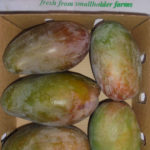
Kenya Mangos
The demand for mango puree and concentrate in the two major world markets has risen since 2014. The Gulf region leads the supply chain with the biggest shipments of processed mangos to the U.A.E. and Saudi Arabia. Europe is the second largest recipient of the fruit’s undiluted extracts, with a 20% share of the world market.
Two key factors stand out that makes Kenya’s mango concentrate and puree market attractive:
1. Some two new processing factories, with a dual production capacity of 90 metric tons, a day.
2. Emerging markets with diverse tastes, in the Arab world and Europe.
There have been two such mango processing plants so far, this decade. The first one was a Tana River factory, in Hola town that began operations in 2012. It currently has a handling capacity of 30 metric tons. The output is helping meet a staggering need of mango puree in, especially, the European market. According to CBI, European puree mostly goes into the fruit juice processing sector. Despite this fact, there is still a high need for natural puree from the tropics, like Kenya.
The second mango processing plant, with a bigger capacity, is based in Tana River. The 2012 factory has the capability to crush 60 metric tons of the raw fruit, daily. This brings the combined output of the dual coastal factories to ninety metric tons a day. The processing venues are a boost for the local farming economy that has been losing its raw mangos from poor post-harvest practices.
In Europe, mango puree features not just in juice making but in consumer foods. For instance, the ice cream sector purchases much of the extracts for value addition to milk-based products. Mango puree is also a major ingredient in baby formulas, due to its high nutrition.
The Gulf region is Kenya’s biggest importer of mangos (raw, puree and concentrate). USAID statistics for the three years of 2006 to 2009 show that between 3,000 and 3,500 metric tons of mangos were exported to the UAE, alone. This was in the two peak years of the period. Neighboring Tanzania ranks as the second largest importer of mangos, as a whole, from Kenya.
The Main Features of Mango processing
Kenya mango procedures follow global standards. The following steps are necessary for making concentrate and puree:
1. The harvest of the different types, including ngowe, kent and keitt takes place. A careful selection of only firm, slightly reddish fruits is necessary to ensure uniform ripening.
2. The fruits undergo phytosanitary handling. This includes washing and inspection.
3. The best fruits are then kept in the ripening warehouses.
4. After a few days, the ripe fruits receive a new washing before crushing takes place. The next step is removing the pulp and the seed, then the treatment of the pulp and concentration in a centrifugal receptacle that separates water content from the juice.
5. The concentrates can store well in clear labeled bottles for one and a half years, in cool dry conditions, below 15 degrees celsius. Canned mango purees can stay for up to two years. They feature the original yellowish color of the mango’s pulp.
A few companies in Kenya provide mango pulp, puree and concentrates, including Selina Wamucii.. Large bottlers like Coca-Cola and Delmonte also produce fruit-based consumer drinks from the fruit.
Other than the nutritious puree and concentrates, Kenya mangos also make these alternative nutrition consumer products:
• Dried confectionaries.
• Brine-tossed green mango.
• Breakfast jam and chutney.
• Seed cosmetics from the fruit’s seeds.
In short, the momentum for mango production in Kenya has picked up in recent years, due to the upsurge of a fruit juice-loving culture, locally and abroad. A buoying factor is the presence of huge processing factories in major mango-growing areas like coastal Kenya. With this trend, the country has become a proud exporter even to neighboring countries and cross-seasonal newcomers like the United States.

